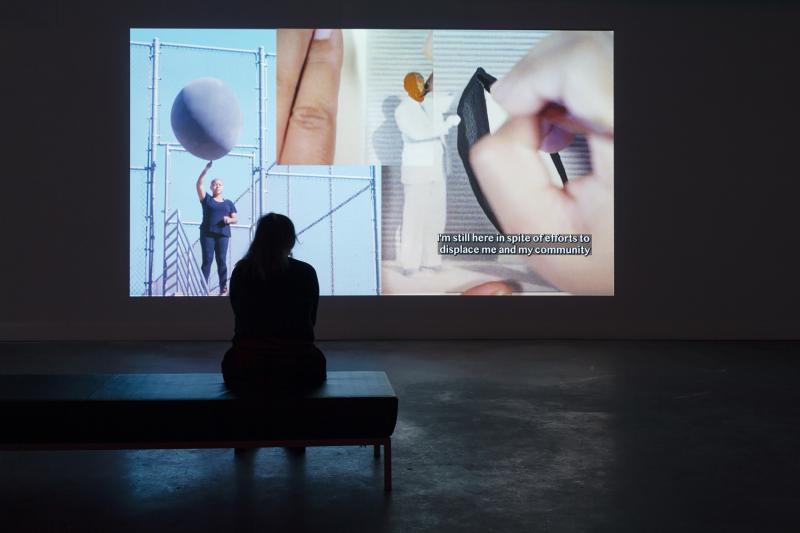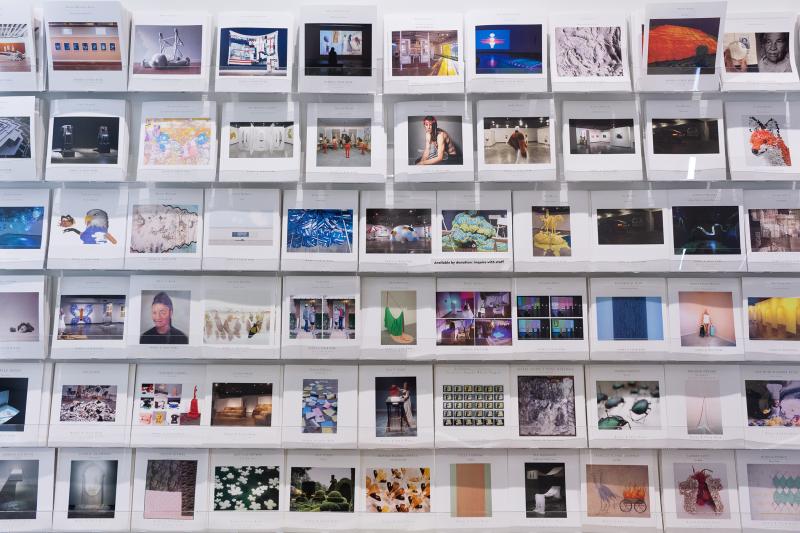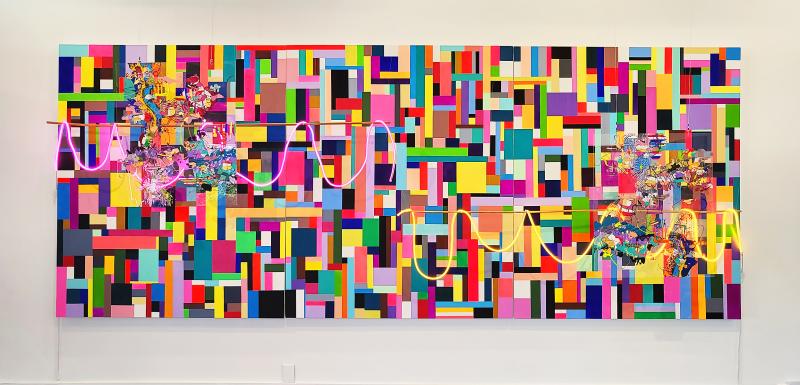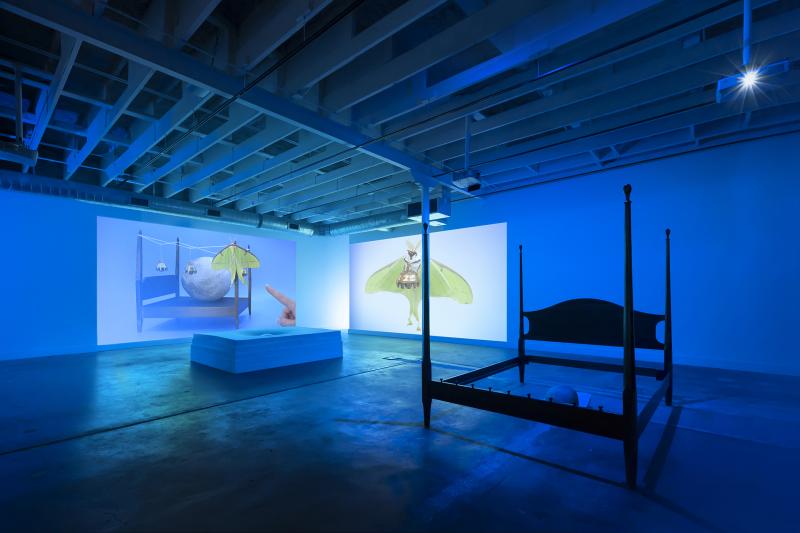Grant Spotlight: Women & Their Work

Visitor viewing Aryel “Ariel” René Jackson’s A Welcoming Place, 2020-2022 (digital video, 29 minutes and 23 seconds). Photo by Alexandra Vanderhider
In 1977, spurred by the lack of opportunities for women in the art world, a group of women artists organized a city-wide Festival of Women in the Arts in Austin, Texas. Over the course of three months, their innovative initiative brought the diverse works of women artists to the forefront, showcasing that work on museum walls, theater stages, music halls, university classrooms, and performance spaces across the city. Attracting over 10,000 attendees, the festival had notable milestones, including the Austin Symphony Orchestra’s first woman director appointed to direct at the festival. Inspired by the festival’s success, in 1978, three women artists established Women & Their Work (W&TW), an organization committed to nurturing the creative development of women visual and performing artists by encouraging them to embrace creative challenges and produce groundbreaking work. Chris Cowden, executive director of W&TW said, “The name reflected their core belief—that art is work, a profession (not a hobby) for which people should be paid like a banker or a plumber, and that women do this work too.”
In January 2024, W&TW received an Arts Endowment grant to support the New Commissioning Project, which involves the creation of solo exhibitions for five emerging women artists. Reflecting on the importance of this project, Cowden said, “Art is so powerful because it affects viewers on multiple levels. There is impact on the head (intellectually), the heart (emotionally), and the soul (spiritually). Women have been excluded from this vital form of communication for many centuries. Their voices and their points of view were not heard, which one could argue has had an enormous impact on the history of the world.”
We spoke with Cowden about the featured exhibitions in the New Commissioning Project, the ways in which the organization connects with the community, and the importance of women’s visibility in the arts.
NEA: Could you share more about the W&TW exhibition program?
CHRIS COWDEN: With our exhibition program, we support artists in many ways. We provide a curatorial advisor of the artist’s choosing to help with aesthetic and technical issues. We commission a writer to write about the work [as part of] color catalogues that are placed in our gallery, online, and mailed to over 100 galleries and libraries. We create an eight-minute, professionally produced video of the artist discussing their work that is available in the gallery and online, and we present Talk About, a conversation with the artist and people who inspire them. We organize ancillary programing—performances, readings, and panel discussions that respond directly to the work or to ideas raised by it to expand the audience and further explore the artist’s ideas.
NEA: What sparked the establishment of the New Commissioning Project?
COWDEN: Women & Their Work wanted to help women artists make new work, experiment with new materials, and explore new ideas all in the hope of taking their work to another level.

Women & Their Work has produced a catalog for each solo exhibition since 1997 (144 to date). These catalogs are displayed at the gallery and include high quality documentation, a commissioned essay, and the artist’s CV. Photo by An Phung
NEA: How did you select the artists that you are working with for the New Commissioning Project?
COWDEN: We issued a state-wide call for entries in which we asked for 10 images of past work, a proposal for what new work the artist wished to create, an artist statement, and a CV [curriculum vitae]. Our artist advisory committee based their choices on the proposal and the achievement of past work: a big leap of faith that has rarely failed to produce remarkably strong work.
NEA: Can you give us a snapshot of what the five New Commissioning Project’s exhibitions entail?
COWDEN: Yuni Lee creates dimensional paintings richly imbued with nostalgia, blending references to her birthplace of Seoul, South Korea, and American culture. In Techstalgia: Echoes from a Small Screen, Lee constructs large-scale, abstract paintings using layers of texture and pattern. She collages traditional Korean fabrics and recycled materials with traditional mediums to create dynamic forms that reference and fuse nature with technology.
Elizabeth Chapin created an immersive installation, a botanical room of trees and mythical figures, to comment on the interconnectedness of all living things. Paintings cut from stretchers are sewn into dimensional forms. These soft sculptures are then animated by a projection-mapped video.
Alejandra Almuelle’s installations juxtapose large, suspended, ceramic sculptural figures with wall installations of clay pieces to suggest a parallel between the earth and the body. She questions a mindset that values the natural world and human beings as resources and examines how territories and their peoples have been historically shaped for extraction, production, consumption, and ownership.
Monica Martinez-Díaz explores the inherited complexities inherent to the MX-U.S. [Mexican-United States] border territory and her upbringing in such an ambivalent environment. The recent death of her grandfather in Juárez, Mexico, inspires work that contrasts life and loss, beauty, and sadness—prompting a dialogue between domestic spaces, objects, and mourning.
Using virtual reality, 3D animation, augmented reality and installation, Hiba Ali creates immersive worlds of sound, smell, and enhanced visual experiences. These environments serve as portals that slow down time and connect us to ancestors, descendants, and our communities creating access to a network of calmness, solace, and care.

Yuni Lee's solo exhibition: Techno Tessellation, mixed media on canvas and plexiglass, neon, 72 x 180”. Photo by Essentials Creative
NEA: What do you hope people take away from viewing the New Commissioning Project exhibitions?
COWDEN: I hope viewers think about the remarkable range of ideas, materials, techniques, and effects that this group of five women have created. Contemporary art has such breadth; there is literally something for every viewer. Many people feel inadequate viewing the art of our time. I hope to banish this response. There is so much to be enjoyed by just responding to the environment each artist has created, noticing the colors, shapes, sounds, and scents that underly the exhibition.
NEA: What are some of the other ways in which W&TW engages with the community?
COWDEN: W&TW presents over 50 events a year. We have on-going exhibitions, an arts education program that serves over 1,000 under-resourced school children, performances, artist talks, and community conversations—most of which are presented free to all of Austin. Since 1986, W&TW has reached thousands of children who might never have visited a gallery or met a working artist. W&TW's arts education program provides gallery tours and talks with exhibiting artists, hands-on art workshops, and professional development for teachers. These services are offered at no charge to students and teachers. Beginning in 2013, W&TW collaborates with AISD [Austin Independent School District] to provide art experiences for the GO Project, a program for young adults with special needs (from ages 18-22). In collaboration with Art on the GO, W&TW designs programs specifically for these disabled adults and serves 75 of them several times a year.
W&TW has collaborated with the Fusebox Festival for 14 years to bring performers to Austin. The Fusebox Festival has grown to be one of the most acclaimed performance festivals in the United States, drawing over 8,000 people to performance venues and other non-traditional spaces. We also offer our space for fundraisers and projects to other art organizations and artists as space allows.

Installation view of Virginia L. Montgomery’s (VLM) exhibition Eye Moon Cocoon, 2023. Photo by Essentials Creative
NEA: How has funding from the NEA helped support the work of your organization?
COWDEN: The NEA has had an outsized impact on W&TW. We were the first organization in Texas to be awarded a grant from the NEA in visual art. That early stamp of approval from a national grantor led to W&TW acquiring other support. We would not have been able to do what we do without support from the NEA.
NEA: What do you wish you could do more of as an organization?
COWDEN: There is never enough time or enough space to meet the needs of the artists whose work we have come to know. We’d like more exhibitions, more community conversations, more performances. Art brings people together; there can never be enough of it.
NEA: What advice do you have for aspiring artists?
COWDEN: Develop the hide of a rhinoceros because you must endure rejection after rejection; you must apply for exhibitions again and again. Never give up. It may take 10 rejections before you get an acceptance letter. Try to look at each rejection as being one step closer to getting that acceptance.
NEA: Finish this sentence. Women’s visibility matters because…
COWDEN: Women’s visibility in the world is vital. Women’s voices must be seen and heard!




